Today we offer the La La’s:s La Mouline (89% Syrah 11% Viognier), La Turque (93% Syrah 7% Viognier, and La Landone (100% Syrah).
Vintages from 2008, 2011, 2012, 2013 & 2014!
The wines of Côte-Rôtie (the roasted slopes) and Hermitage in the Northern reaches of the Rhône Valley, have justifiably garnered critical acclaim. Where Hermitage reds are 100% Syrah, the wines of Côte-Rôtie, it’s neighbour to the north, are often blended with a small percentage of Viognier.
These very wines provided inspiration in pushing the growing and making of Shiraz at Yarra Yering. The ‘Underhill’ 100% Shiraz and the Dry Red No. 2 a Shiraz Viognier blend with a splash of a couple of other Rhône Varieties in the mix. It’s not surprising that we drank a truckload of Rhône wines at Yarra Yering. One Easter weekend during the 2003 harvest Doc, myself and one other, were doing a half day picking a few buckets of fruit and maintaining the ferments. We pulled stumps at about 1pm. Doc, made his way to the cellars and popped back up with a 1994 La Turque. One of Guigal’s trilogy of top Côte-Rôties along with La Mouline and La Landone, affectionately known as the La La’s.
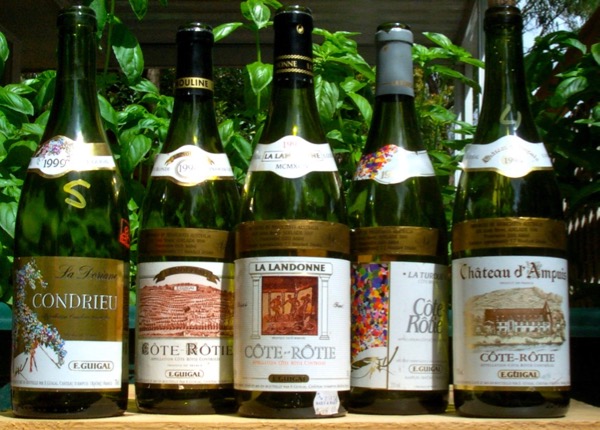
We start a glass, baiting Doc,”We really need to try the other two to understand what’s going on!” Doc disappeared. A couple of minutes later, all three were in front of us. Drinking these wines was fascinating, the La Mouline incredibly opulent, Viognier shining through. La Turque, structured and earthy. La Ladone in the middle, with perhaps the best line, length, and, harmony for the wines on the day. It made us think about layering in extra depth of tannin, how we could add another level of sophistication to the mouthfeel. Just how could we bring more of the inherent complexity in the fruit to the fore?
Tips for Drinking these Wines
🌡Temp: For the reds 16°C. We tend to drink reds an edge warm. There’s nothing wrong with chucking the bottles in the fridge for 15minutes to drop a few degrees off them. If they end up too cold they’ll warm up quickly in the glass. For the Condrieu 12-13°C works well.
🍷Decanting: Definitely, if drinking it under 10 years old. It will probably be better the next day!
⏳Time: I love trying good wines stand alone, with food, and, often the next day. It gives them the chance to shine and ensures you don’t miss a good wine through impatience or fail to bring out it’s best by not marrying them to food.
🕯Cellaring: The La La’s tends to go through a couple of phases in the cellar. On release, they are bold wines. Over 3-10 years they harmonise and secondary development starts. The real magic happens from 15+ years, they hit a phase where they appear almost transparent to taste, yet retain incredible depth of flavour, the complexity levels lift another notch, keeping you entranced by the wine’s scent alone.
🥩Food Match: For the reds just think red meats, braises, pork, rabbit. As they reach the third phase go with the lighter meats. Condrieu, is no shrinking violet, Guigal actually list the following, drink it as an aperitif (it is a stand alone meal), foie gras or scrambled egg and truffles. Delicate fish. It will happily hold lighter poultry, veal and pork with more delicate sauces.
What happens when you blend Shiraz & Viognier
The blending of Shiraz and the white grape Viognier originated in Côte-Rôtie. The interplay between the two varieties is truly something special.
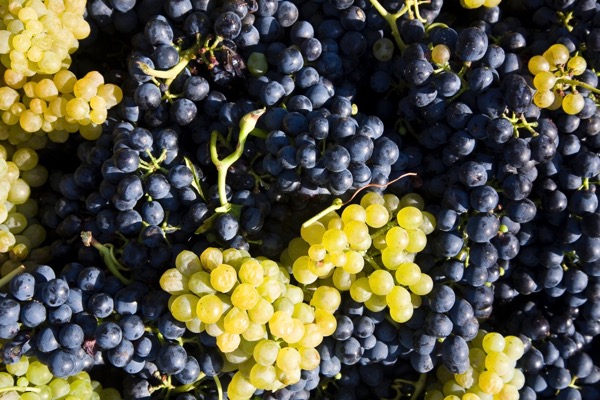
Co-fermenting rather than blending finished wines simply results in greater harmony and expression.
The colour of the wine becomes darker as a scientific phenomenon known as co-pigmentation occurs, small compounds from the Viognier stabilises the large colour compounds from the Shiraz.
Perfume, flowers, and, spice from the Viognier adding intrigue to the aroma. Making it so much more inviting!
Those aromas carry through to the palate where the last bit of magic happens. The tannins develop differently to 100% Shiraz wines, beautifully refined, and, silky they offer a wonderful feeling in your mouth. mouthfeel.
Tim Kirk from Clonkilla was kindly sent me a mixed case, including some experimental wines not for release. In it, 3 wines, 100% Viognier, 100% Shiraz, the components of his Shiraz Viognier, and, the Shiraz Viognier itself. A fascinating tasting, you could see how each of the component wines contributed to the blend. The blend just had something extra. This is the result of fermenting the red grapes of Shiraz with the white Viognier. The chemical soup that exists during fermentation ends up coming together to be greater than the sum of its parts.
In Côte-Rôtie the vineyards are mixed plantings with Viognier vines next to Shiraz, all picked at the same time. The proportion of Viognier ranging from none up to 10-12%.
Viognier
The Vixen Viognier comes to us in many forms. At one end of the spectrum, they are vibrant fresh, acid driven wines, with low phenolics (small tannin molecules that can add to the texture of white wine), at the other they are bold, full-bodied, unctuous wines with an almost oily texture that caresses your tongue.
Each maker has to decide where on the spectrum they want to sit. The biggest influencers of style being picking time, extraction of phenolics at pressing or through skin contact, and, the vessel the wine is aged in prior to bottling.
Fresher styles will be picked earlier, will be pressed gently, have little or no skin contact, and, be fermented and aged in stainless tanks.
Fuller bodied styles will be picked riper, incorporate great levels of phenolics through crushing grapes breaking the skins, pressing harder, or, incorporating a period of skin contact. Typically the will use oak for a portion, to all of the maturing wine.
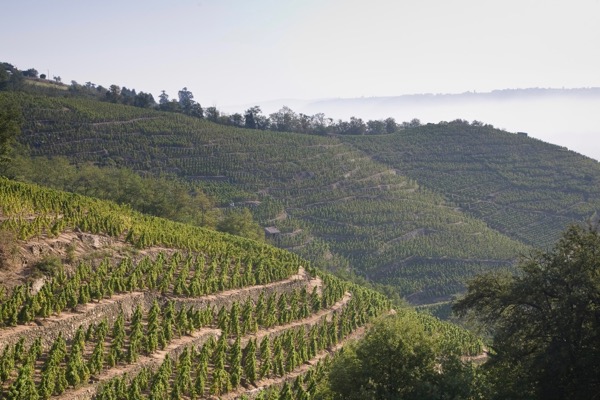
Guigal’s Viognier’s are unique expressions, particularly the La Doriane. When I first tried La Doriane I was blown away. I’d never had something with this kind of texture and power. It was a beast, one that I enjoyed devouring. Where a Chardonnay made like this would likely be undrinkable. The La Doriane was, yes extreme, yet, giving of so much pleasure. The winemaking side of me need to know more. I had the acid levels analysed to find a pH of 4.0 and a Titratable Acidity (TA) of 4g/L. Normally a white wine of this style would have a pH of about 3.4 and a TA of 6.5. Basically it would have a load more acid, the lemon juice character in wine. Technically these numbers are unheard of.
In recent times, Guigal, have pulled back a little and we are seeing great freshness in their Condrieu.
Shiraz or Syrah
You’d think that Shiraz would be easy to explain. The relatively recent expansion of cool climate vineyards throughout Australia, and, experimentation with a wide array of making techniques has seen an increase in the diversity of styles produced. Think Canberra, the Yarra Valley, Adelaide Hills, and, Mornington.
At the same time, the warmer, established regions like the Barossa and McLaren Vale are rapidly evolving the styles of Shiraz they produce. A new wave of producers are making wines of restraint, and, elegance, through earlier picking and careful handling of fruit.
In the Rhône Valley, particularly around Côte-Rôtie, Hermitage and Cornas, we see some extreme vineyards that climb into the skies from the Rhône River at calf breaking angles. Some, terraced, others taking rocks that have made their way to the bottom of the slopes, on an annual pilgrimage back to the top.
When you have exceptional Shiraz the opportunity to experiment with whole berries, whole bunches, stalk use, cold maceration, extended maceration, fermentation vessel, maturation vessel, cap management, and, any of 1,000’s of other variables is possible.
In Australia, we are seeing increasing use of whole bunch ferments for at least a portion of the fruit. The perfume, stalk tannin-rich wines, layering extra dimensions into the aromas and textures of the typically more restrained wines.
Single Vineyard vs Blend
Over time ‘fashions’ have shifted from blends to single vineyard wines. Perhaps driven by the popularity of Burgundy, we’ve seen the Barolista making single vineyard or Cru wines as they call them, Australia has followed, in the 70’s Guigal launched the La La’s, creating three of the now most renowned single vineyard wines of the world.
Staunch ‘terroirists’ will claim a wine loses its identity, it’s sense of place if blended. Personally, I just want to drink great wine, whether, blended or single site. Aldo Conterno’s top wine is a blend of three adjacent vineyards, Vietti’s Castiglione represents, perhaps, their best value Barolo, and, often includes the fruit from the Villero vineyard, that, in exceptional years makes their Riserva, Sandrone’s Le Vigne is a blend, yet all of these wineries also make single vineyard wines. With my consumer hat on I just get to enjoy the fruits of their labour!
Château d’Ampuis is a blend of 7 terroirs. Is it compromised because of this? The vineyards run along a thin strip a few kilometres long, a few hundred meters wide, alongside the Rhône river. In Australia some of our great wines have historically been blends made from grapes grown in the Barossa, McLaren Vale, and, the Hunter Valley, 1,000’s of kilometres apart. By comparison, blending across Côte-Rôtie is more like blending across blocks of a larger vineyard.
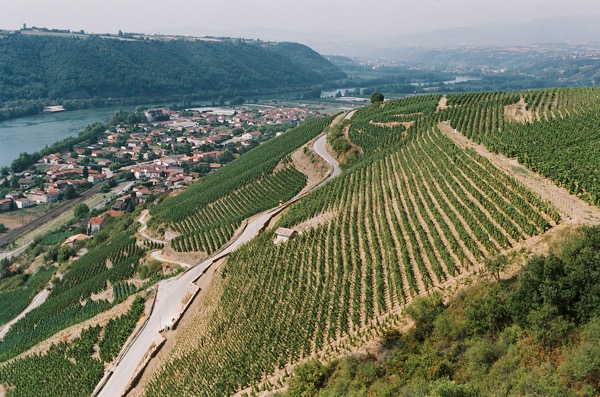
Recently I had the pleasure of sitting down with Stéphane Ogier and trying his Lieux Dits, which translates to ‘said location’, and, refers to a specific site akin to a single vineyard. Trying 6 of his Lieux Dits across both the Côte Blonde and Brune was a fantastic experience, as Stéphane walked us through the sites, terms like feminine, masculine, floral, savoury, earthy, and structured come through. Each wine had a great personality. Most would stand on their own, one or two looked to offer more structural elements, without the balance of fruit weight, although this judgement needs to be reserved given the youth of the wine. Tasting aged wines from the Ogier demonstrated just how much the blossom after just a few extra years in bottle. When we got to the blended Reserve, containing each of the Lieux Dits, the whole, was definitely greater than the sum of the parts. The poise and harmony of the wine were at the next level.
So, my challenge to Guigal is to make a 4 pack with the 3 La La’s individually and a blend of the 3 La La’s!
About Guigal
Guigal is one of those epic wineries that can make a bucket load of Côte du Rhône, put it on the shelf at around $20 a bottle, when many would be happy to pay $30, and, at the same time makes some of the word most unique wines. They have a built a legacy and in so doing dragged Côte-Rôtie from near ruin to the very pinnacle of the wine world.
The decision to drive quality release the La La’s drew focus and investment to the region, today it is a vibrant, growing, and making superb wines of real personality.
The film below, in French will give you a little insight into the region, viticulture, winemaking and of course, Guigal. There’s a series of films at the end of the offer covering the work through the different seasons.
Where in the World are They?
Today’s wines all hail from the Northern part of the Rhône Valley between Vienne and Valence.
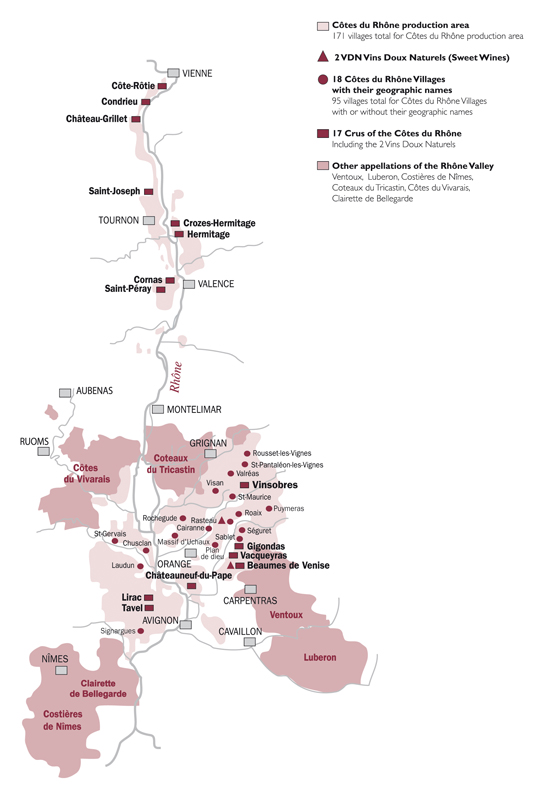
Below you can see Côte-Rôtie with all of it’s vineyards mapped out. To the South you can just see Condrieu in the picture. Hermitage is some 50km further South down the Rhône River.
Côte-Rôtie itself is split into to main sub-regions, the Côte Blonde and the Côte Brune.
If you face the hill from the Château d’Ampuis itself to the South you find the Côte Blonde, where soils are heavy with granite and produce elegance feminine wines.
To the North lies the Côte Brune, here the soils comprise mica schists and clay, yielding more masculine, structured wines.
Like Burgundy, individual vineyards in Côte-Rôtie have been identified, named, and, clear boundaries established.
The Guigal’s Château d’Ampuis wine is made from 7 of these vineyards with a mix from the Côte Blonde and Côte Brune: Le Clos “Côte Blonde”, La Garde “Côte Blonde”, La Grande Plantée “Côte Blonde”, La Pommière “Côte Brune”, Le Pavillon Rouge “Côte Brune”. Le Moulin “Côte Brune” La Viria “Côte Brune”
Where Hermitage is dominated by 4 main producers, including Guigal, Côte-Rôtie, now has around 100 producers making wine from it’s 550acres of plantings.
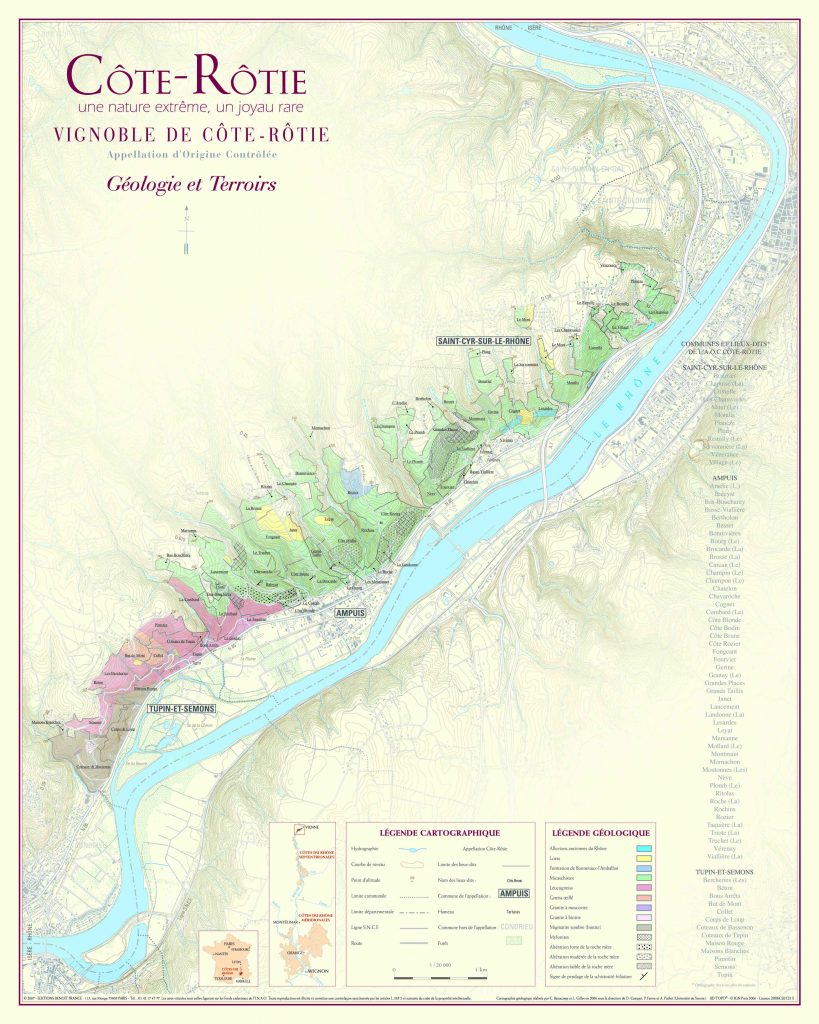
About the Wines
2008 La Landone
Soil type – Limestone clay very rich in iron oxyde.
Grape variety – 100% Syrah.
Average age of vines – 35 years Vines planted in the 16th century.
Winemaking – Closed stainless steel tanks. Temperature controlled alcoholic fermentation, 4 week maceration.
Ageing – 42 months in new oak.
Average Yield – 35 Hl/hectare.
The most successful of the three Cote Roties in 2008, the 2008 Cote Rotie la Landonne is a candidate for the wine of the vintage. Cigar tobacco, pepper, cured meats and abundant dark fruits all give way to a full-bodied, balanced, impressively concentrated wine that has integrated acidity, plenty of fruit and solid ripeness to its tannin. Opting to use 100% stems during the fermentation, the Guigals questioned whether the '08 should see the standard 4 years in barrel, but after continually tasting the wine (this father/son team tastes more frequently - and quickly - than just about any vignerons I know), they opted to keep it in barrel for the full duration. It's absorbed every trace of it's oak elevage and is drinking nicely today. 09/15
Saturated ruby. An impressively complex nose evokes blackberry, dark chocolate, violet and cigar tobacco, with a strong spicy note emerging with air. Offers sweet, deeply pitched dark fruit compote and floral pastille flavors that are given spine by juicy acidity. No way I'd guess from this wine's concentration that it was an '08. Finishes with superb persistence, lively notes of violets and black pepper and slow-building tannins. A really remarkable performance for the year. 03/13
2011 La Turque
Soil type – Silicone limestone with schistes producing clay soil rich in iron oxyde.
Grape variety – 93% Syrah, 7% Viognier.
Average age of vines – 25 years Vines planted in the 16th century.
Winemaking – Closed stainless steel tanks. Temperature controlled alcoholic fermentation, 4 week maceration.
Ageing – 42 months in new oak.
Average Yield – 35 Hl/hectare.
The 2011 Cote Rotie la Turque is about as seamless and sexy as wine gets, and this cuvee continues to put on weight and richness with every passing year. Offering a monstrous nose of Asian spices, kirsch liqueur, blackcurrants, pepper and smoked meats, this full-bodied Cote Rotie has layers of sweet tannin, no hard edges and a killer finish. It's already hard to resist today, but has three decades of prime drinking to go. 12/16
Inky ruby. A highly complex bouquet evokes candied dark berries, cherry cola, incense and potpourri. Offers intense, seductively sweet black and blue fruit, cola and violet pastille flavors enlivened by juicy acidity and peppery spices. Closes extremely long and juicy, displaying a bright mineral quality and building tannins and leaving behind a suave floral note. 03/16
2012 La Turque
Similar to the La Mouline with its forward, incredibly sexy style, the 2012 Côte Rôtie La Turque (there’s 7% Viognier in the blend) offers a saturated purple color to go with meaty, smoky notes of cassis, cured meats, chocolate and roasted herbs. It’s a big mouthful of a wine, with full-bodied richness and a stacked mid-palate, but it has a seamless, weightless texture, perfectly ripe tannin and a blockbuster finish. I’d happily drink a glass today, but it should be at its finest from 2020-2046. 12/16
Youthful violet. Powerful, smoke- and mineral-accented black and blue fruits and incense on the explosively perfumed nose. Stains the palate with sweet blueberry, cherry, violet pastille and spicecake flavors that show superb depth as well as vivacity. Seamless and alluringly sweet; a core of juicy acidity adds lift and spine. Supple tannins build steadily on an extremely long, focused finish that leaves suave floral and Moroccan spice notes behind. 7/17
2014 La Turque
Now that it's in bottle, the 2014 Cote Rotie La Turque has exceeded all of my earlier expectations. It's got those classic Côte Rôtie elements on the nose of smoked bacon, olives and violets, seamlessly entwined with supple tannins and raspberry fruit. Medium to full-bodied, it's silky and fine, showing tremendous length and complexity on the finish. On this occasion, La Turque came to the head of the class as the most approachable, exciting and elegant of the three La Las.
Inky ruby. Powerful, deep-pitched aromas of ripe black and blue fruits, violet, incense, exotic spices and minerals. Stains the palate with intense blueberry, cherry liqueur and floral pastille flavors that stretch and become sweeter with aeration. The mix of power and finesse here is fabulous. A strikingly long, youthfully tannic finish shows superb delineation and leaves sweet blue fruit and spicecake qualities behind.
2011 La Mouline
Soil type – Terraced wines in the shape of a Roman amphitheatre. Gneis with lighly coloured silicone soil with limestone lœss.
Grape variety – 89% Syrah, 11% Viognier.
Average age of vines – 75 years Vines planted in the 16th century.
Winemaking – Closed stainless steel tanks. Temperature controlled alcoholic fermentation, 4 week maceration.
Ageing – 42 months in new oak.
Average Yield – 35 Hl/hectare.
Starting out the single vineyards and bottled in February (after over four years in new oak barrels), the 2011 Cote Rotie la Mouline is as slutty, sexy and seamless as they come. Full-bodied, thrillingly concentrated and unctuous, it offers classic Mouline notes of cured meats, violets, black raspberries, espresso and hints of vanilla bean. Philippe Guigal commented that the worst thing about 2011 was the it came after 2010, and while the previous two vintages will get all of the attention, this 2011 will deliver almost as much pleasure, and do it right from the start as well. It needs 3-4 years of cellaring and will drink sensationally through 2041. 12/15
Deep ruby. Sexy mineral- and spice-laced black raspberry, cherry compote and floral pastille aromas are complemented by notes of Asian spices, cola and smoky oak. Spicy and precise on the palate, offering vibrant, spice-accented red and dark berry and cola flavors and an undercurrent of smoky minerality. Fine-grained tannins sneak in very slowly and meld seamlessly with the energetic fruit. Clings with fantastic tenacity and focus, leaving behind vibrant spice, berry liqueur and mineral notes. 3/16
2013 La Mouline
The 2013 Cote Rotie La Mouline shows none of the vintage’s sometimes dry tannins. It offers crisp black fruit—plums and blackberries—underscored by hints of pencil shavings, espresso and grilled meat. Suave and long, it should drink well for a couple of decades. 12/17
(made with 50 percent whole clusters) Bright purple. A complex, intensely perfumed bouquet of fresh black and blue fruit, candied licorice and Asian spice scents develops a sexy floral note as the wine opens up. Vibrant and appealingly sweet on the palate, offering intense, smoke-tinged black currant, boysenberry, floral pastille and spicecake flavors energized by a refreshing snap of juicy acidity. Blends richness and vivacity with a deft hand and finishes extremely long and gently tannic, leaving a sappy blue fruit note behind.
2014 La Mouline
Floral aromas accent sturdy notes of grilled meat and almost delicate notes of red berries in the open, approachable 2014 Cote Rotie La Mouline. Medium to full-bodied, it shows great purity and a supple, silky, classic feel. It's built more on elegance and complexity than power, with those floral, herbal notes leaving a long, silky impression on the finish. 11/18
Glass-staining ruby. Lively, intensely perfumed aromas of red and blue fruit preserves, Moroccan spices, potpourri and incense are sharpened by a smoky mineral nuance. Juicy and pure on the palate, displaying seductively sweet boysenberry and cherry liqueur flavors along with hints of candied violet and spicecake. The floral and spice notes return emphatically on the extremely long, penetrating finish, which features velvety tannins and a hint of five-spice powder.

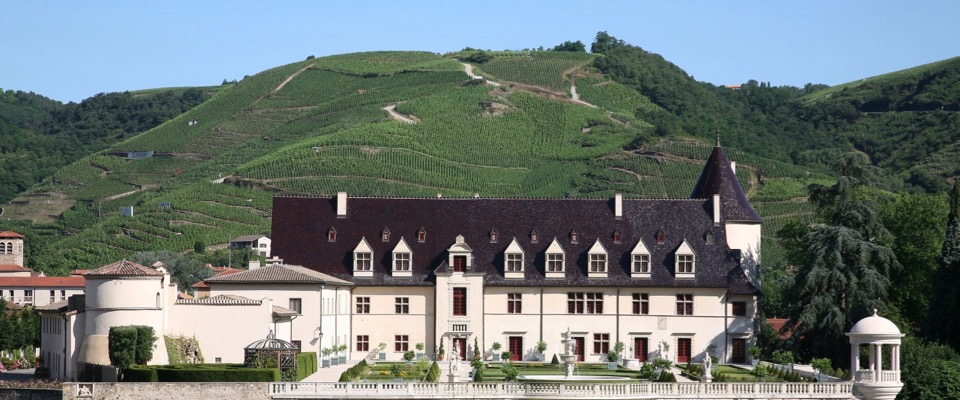



You must be logged in to post a comment.